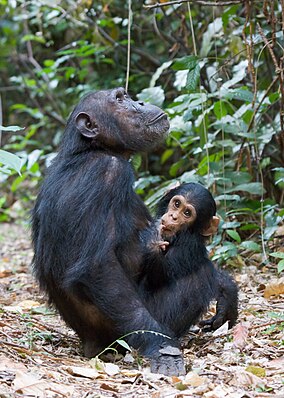Apart from watching movies or those addictive series i love the National Geographic channel ,yesterday evening while i was busy cuddling my coach pillow i decided to watch nothing else but the National Geographical channel,while i was watching some commercial attracted my attention ,it was about Chimpanzees.
There is nothing good about them,actually i wonder when i meet with one in reality how will i react ?Perhaps i will act like like Jane Goodall.
I threw the pillow that i was cuddling and grabbed my old looking National Geographic magazine and learned a few about Gombe National Park found in my town. Why not share with you?
Gombe Stream National Park is located in western Tanzania, 10 miles (20 km) north of Kigoma, the regional capital of western Tanzania. Established in 1968, Gombe is the smallest national park in Tanzania, with only 20 square miles (52 km2) of forest running along the hills of the eastern shore of Lake Tanganyika.The terrain is distinguished by steep valleys, and the forest vegetation ranges from grassland to alpine bamboo to tropical rainforest. Accessible only by boat, the park is most famous as the location where Jane Goodall pioneered her behavioral research conducted on the chimpanzee populations. The Kasakela chimpanzee community, featured in several books and documentaries, lives in Gombe Stream National Park.
Gombe Stream’s high levels of diversity make it an increasingly popular tourist destination. Besides chimpanzees, primates inhabiting Gombe Stream include beachcomber olive baboons, red-tailed monkeys and vervet monkeys. The park is also home to over 200 bird species and bushpigs.There are also 11 species of snakes, and occasional hippopotamus and leopards. Visitors to the park can trek into the forest to view the chimpanzees, as well as swim and snorkel in Lake Tanganyika with almost 100 kinds of colorful cichlid fish.


Jane Goodall first traveled to Tanzania in 1960 at the age of 26 with no formal college training.At the time, it was accepted that humans were undoubtedly similar to chimpanzees—we share over 98% of the same genetic code.
However, little was known about chimpanzee behavior or community
structure. At the time she began her research, she says “it was not
permissible, at least not in ethological circles, to talk about an
animal's mind. Only humans had minds. Nor was it quite proper to talk
about animal personality. Of course everyone knew that they did have
their own unique characters--everyone who had ever owned a dog or other
pet was aware of that. But ethologists, striving to make theirs a "hard"
science, shied away from the task of trying to explain such things
objectively.”
However, her research eventually proved just that—the intellectual and
emotional sophistication of non-humans, chimpanzees in particular. With
the support of renowned anthropologist Louis Leakey, Goodall set up a
small research station in Gombe Stream in hopes of learning more about
the behavior of our closest relatives. There she spent months tracking the elusive chimpanzee troops, particularly the Kasakela chimpanzee community,
and observing their daily habits until she was slowly accepted by one
troop and was allowed rare and intimate glimpses into chimpanzee
society.
 | ||||||
| Jane Goodall |
Benefits for Gombe Stream and Tanzania
Today Goodall uses the publicity from her research to advocate for chimpanzee welfare, the conservation of biodiversity, and general stewardship of the Earth. She founded the Jane Goodall Institute in 1977, as well as the youth-focused environmental group Roots & Shoots in 1991 which now has over 800 groups in nearly 90 countries around the world. The research conducted by Goodall at Gombe Stream is of great value both to the scientific community and to the park itself. At the time she began her research, Gombe Stream was only a game reserve, and her groundbreaking research encouraged support for making the reserve into a national park. The large amounts of publicity her findings received have also brought international attention to Tanzania. Tourism and financial support from donors has benefited not only the park, but the people and conservation efforts of Tanzania as a whole.Goodall lived at Gombe Stream almost full-time for fifteen years and the long-term data she accumulated is still of value to scientists today.In 1967, the Gombe Stream Research Center (GSRC) was established to coordinate ongoing chimpanzee research in the park.Run mostly by a team of trained Tanzanians, the GSRC is the longest running field study of an animals species in their natural surroundings, now over 40 years. This long-term data has provided scientists with insight into chimpanzee demographic patterns, male politics, hunting, culture and mother-infant relationships over multiple generations—rare and valuable data. The ongoing research is also providing information on the current threats to chimpanzees, such as disease, poaching and habitat disturbance, which affect other species at Gombe as well.The research of Goodall has also drastically changed ethological thinking and how behavioral studies are conducted. Where once talk of animal emotion was dismissed as anthropomorphism, her observations of animals in their natural habitat show that societies, behavior and relationships between animals are quite complex. Her research of chimpanzee habitat (food and special) requirements also aid in improved design for new protected areas.The GSRC also conducts research on the baboon population, led by the Jane Goodall Center for Primate Studies. Research from the GSRC has resulted in 35 Ph.D. theses, over 400 papers and 30 books.












0 comments:
Post a Comment